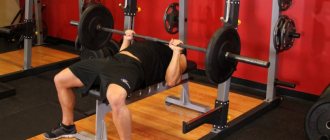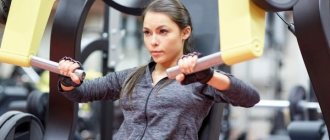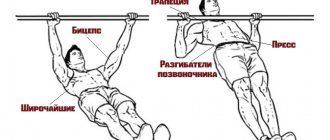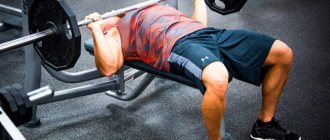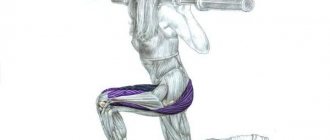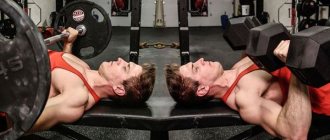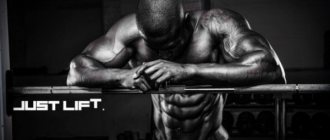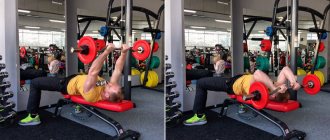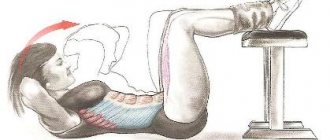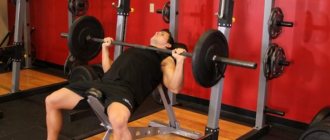What muscles work on the incline bench press?
The incline barbell bench press is considered one of the basic and key techniques for pumping and increasing the relief of the thoracic segment of the muscles. The most popular modifications are bench presses at an angle of 30 and 45 degrees, which distribute the load on the upper pectoral muscles. For beginners, it is better to perform the barbell press with an empty bar, without weight, under the supervision of a trainer. This will allow you to consolidate the correct parameters for performing the press.
Main muscle group
:
pectoral Additional group: serratus anterior, rhomboid and lower trapezius, shoulder rotators, biceps, triceps, abdominal and buttock muscles, latissimus dorsi Difficulty level: medium Load type: Basic, multi-joint
Technique
Load distribution
The 30-degree barbell press primarily targets the mid-chest muscle group and some of the upper chest. The inclination of the bench at 45 degrees involves the upper area in the work. To pump up the lower group of chest muscles, the incline bench press is performed in a modification with an upside down incline.
Elbow position.
When spreading the elbows to the sides, the activity of the triceps decreases, and the work of the pectoral muscle group increases (which are pumped in the exercise). It is permissible in the lower maximum of the press to bring the elbows to the body and spread to the sides.
Hand placement options
Narrow grip. To reduce the level of load on the thoracic segment and increase the work of the triceps muscle and anterior deltoids, grab the bar with a narrow grip. The range of movement with a narrow grip is maximum. Wide stance. For maximum pumping of the upper and middle pectoral muscles, use a wide position of your hands on the bar. This modification will reduce the range of motion.
Equipment modifications
Reverse grip press. Smith Bench Angle Press Modification. Use of Dumbbells. Angle Press in a Power Rack.
Practical nuances and aspects
To ensure that the bent-over bench press brings maximum results, use these tips:
The emphasis is not on weight, but on execution technique. It is better to choose a lower working weight with which you will feel comfortable. Press your heels or entire foot into the floor. This will increase your fixation, stability and emphasis. Points of contact of the body with the bench: head, both shoulders and shoulder blades, sacrum. Maintain a natural arch in the back while performing the press and keep the shoulder blades retracted to minimize the risk of injury. The higher the angle, the wider the grip. Lower the bar firmly into the collarbone area, but do not place the barbell on your chest. In this case, a slight pull of the head back is quite acceptable. Lower the barbell to the widow slower than you raise it. At the bottom point of the exercise, keep your forearms vertical. Absorb inertia to prevent injury. When you lie down on the bench, arch your spine and push your chest forward.
Bench press in the general training scheme
First, the main general muscle training is performed, and only after that they begin to load isolated segments of the pectoral muscle group. The incline press is done after basic training, for example, the classic press technique, dips.
Execution technique - how to do the exercise correctly
- Tilt the back of the bench down and prepare the required weight on the bar. Lie down on a bench so that the bar is level with your lower chest. Grasp the bar with an overhand grip (palms facing down), wider than shoulder level. Remove the bar clamps and hold it with your arms outstretched (your elbows should be slightly bent and not completely straightened). This is the starting position.
- Slowly lower the barbell down until the bar is a few centimeters from your chest (avoid touching).
- Pause briefly and press the weight upward with a powerful movement, returning to the starting position.
- It is necessary to lower the barbell at a slow pace, this will help maintain muscle concentration. You need to press the weight at a fast pace, in one powerful movement.
- Don't let the bar touch your chest to avoid bounce. This will reduce the load and make the exercise less effective;
- Never extend your arms completely, this will help maintain tension and reduce stress on the elbow joints;
- The grip should be wider than shoulder level, otherwise the load from the pectoral muscles will transfer to the front deltoids;
- Check out the article.
The California Press (JM Press) is an excellent compound exercise that can target all three heads of the triceps. This exercise will help you increase the mass and strength of your triceps.
Target muscles: Triceps
Equipment: simulator
Starting position - lying with your back on a horizontal bench in a Smith machine, buttocks pressed to the bench, feet resting on the floor. Take the barbell with an overhand grip slightly narrower than shoulder width at a distance of approximately 25-30cm between your palms. Inhale and slowly lower the barbell just above the level of the upper chest, towards the chin, in fact only a couple of centimeters below the neck, at the lowest point the triceps muscles will be maximally tense. Compared to the main basic exercise, the bar does not fall to the top of the chest, but hangs above the level of the neck. From the bottom position, press the barbell up and back and exhale when finished. At the top point, the arms should be almost fully extended - the position is strictly perpendicular to the bottom point. Locking the elbows above the lower section of the pectoral muscles is not permissible. When performing the exercise, the elbows must be kept pressed to the body. For maximum results, lowering the barbell should be done slowly, and raising it 2-3 times faster.
Random Exercise
Random program
Execution Sequence
1. Set the degree of inclination of the bench depending on which muscle segment you want to pump. 2. Install the barbell and equip it with working weight. Remember to use clamps on both ends of the projectile. If you are a beginner, perform bench presses with an empty bar. 3. Starting position: lying on a bench, hold the bar with an overhand grip above the body. 4. Only your palms should support the barbell, and place your thumb on top of it. 5. While inhaling, smoothly and at a slow pace lower the bar so that it touches the upper segment of the chest. 6. Straining your muscles, fix the position for 1-2 seconds. 7. While exhaling, use the muscles of the upper chest segment to squeeze the barbell and return to the starting position. 8. Don't throw the projectile onto your chest, but don't push it up uncontrollably either. Maintain a smooth, moderate pace throughout the exercise. 9. Repeat the barbell press at 45 degrees the desired number of times.
Smith machine barbell press variations
Your position on the Smith machine affects which muscles will be worked during the exercise.
Seated press (classic version) – we work the shoulders and chest muscles
This type of press allows you to work your shoulders.
Before you begin to perform the bench press in a seated position, you need to adjust the back of the bench - it should be tilted from 80 to 85 degrees (almost a vertical angle). The edge of the backrest should be located approximately under the barbell.
- Starting position - sit on the bench so that the bar is located in front of you. The feet are firmly on the floor, the pelvis and back rest against the back of the bench. We grab the bar with a straight wide grip (military grip), elbows pointing to the sides. Rotate the bar to remove it from the hooks and lower it to approximately chin level.
- As you exhale, using the shoulder muscles, press the weight above you, but do not straighten your arms completely.
- While inhaling, we return to the starting position.
- We continue to perform seated presses in the Smith machine until the set is completed.
Beginners are recommended to perform 8 repetitions for each of 3 sets. If this is not your first time doing this exercise, you should do 10 repetitions for 4 sets. Well, for more experienced athletes, 12 repetitions and 4–5 approaches are desirable.
Video: Performing a classic version of the seated press in a Smith machine (lifting the barbell up with a narrow and military grip)
Smith machine incline press
This version of the bench press is performed on an inclined bench at an angle of 30 to 60 degrees. With an incline press, muscle development occurs in the upper chest area.
- Starting position - sit on an inclined bench so that the bar of the barbell is above the upper chest. The feet are firmly planted on a horizontal surface. We put our head on the back of the bench, bringing our shoulder blades together. We grab the bar with a straight wide grip and remove the bar from the hooks.
- As you inhale, gradually lower the barbell until it touches your upper chest.
- As you exhale, squeeze it out, but do not straighten your arms all the way.
- We return to the starting position.
- We continue to perform the bench press until the set is completed.
Video: Incline bench press in Smith machine
Reverse grip seated press
The main load when performing this exercise falls on the anterior deltoid, the secondary load on the triceps. It is very important to grasp the barbell with a closed grip - when the thumb seems to close the grip, it is not recommended to use a narrow grip to avoid the bar falling on your face. The gymnastic bench should be installed at an angle of 80 degrees.
- Starting position - sit on a bench, rest your back and lower back against the backrest, feet firmly on a horizontal surface. We take the bar with a straight closed grip and remove it from the hooks.
- As you exhale, press the barbell up, but do not straighten your arms all the way.
- As you inhale, lower the barbell until it touches the bottom of your collarbone. Your elbows should move forward a little.
- We continue performing the exercise until the approach is completed.
The number of repetitions and sets varies from 10 to 15 and from 3 to 5, respectively, depending on your level of physical fitness.
Basic mistakes
Incorrect bench angle. An inclination angle of more than 60 degrees will shift the emphasis to the deltas. Lifting of the pelvis and head from the bench, excessive arching of the back in the lumbar and thoracic regions. This position places the load on the shoulders rather than on the chest. The point of lowering the barbell is located slightly higher than during a bench press. Throwing a projectile onto the collarbone can result in bone injuries. The correct point is found experimentally: at the lowest point you need to hold your forearms perpendicular to the floor surface. Squeeze the barbell until your arms are straight. When the arms are fully extended, the load is redistributed not to the pectoral muscles, but to the triceps brachii. Therefore, it is important to keep your elbows slightly bent. You should lower and squeeze the apparatus at an angle. Vertical movement creates extra stress on the shoulder muscles, which increases the risk of injury. In case of working with heavy weights, it is recommended to have a spotter. Number of repetitions: 3 sets of 10-12 repetitions Weight: The working weight is selected such that you can repeat the bench press 10-12 times
Number of repetitions
: 3 sets of 10-12 repetitions
Weight
: The working weight is selected so as to repeat the bench press 10-12 times
Set of exercises
Bench press
Bench press
The most popular type of exercise on the Smith machine. Especially suitable for those athletes who work without a belay partner. Safety is ensured by special stoppers that will hold the barbell if it begins to put pressure on the athlete.
So you can forget about the fear of a falling bar and give your all on the machine. This will be helped by special clamps that will not allow the load to spread to non-target muscles. Read more in the article about the classic technique.
Chin pull
Here is the technique described in the classics. The design of the machine may not allow a beginner to fully enjoy the strength exercise and feel the real benefits. Therefore, before starting to perform the elements, you should adjust “for yourself” between the sports equipment and the toes.
This will help you feel more comfortable and not overcome unnecessary difficulties. Chin rows are the best choice for those who want to tone their deltoid muscles.
Seated press
Here, too, you need to take advantage of the design features of the Smith machine. Finding a comfortable starting position is done by moving the bench in relation to the barbell. Details.
Squats
The technique is quite simple and will help shift the focus to the development of the muscle group of the hips and buttocks. When training with a free barbell, such “tricks” will not work. In addition, the Smith machine allows you to exercise with much more weight, which promotes rapid muscle growth. Details here.
Bench press at an angle video exercise
Brief conclusions
The incline barbell press is considered basic for improving the muscles of the upper segment of the body, forming a wide and powerful chest. Anatomically, the technique resembles push-ups, but the use of a barbell allows you to use additional weight.
Correct execution of the incline bench press technique requires that the feet are pressed to the floor, the shoulder blades are retracted, and a minimum deflection is maintained in the back. The pelvis is pressed against the support bench. The barbell must be lowered diagonally, and at the lowest point of the amplitude, do not lower it all the way to the collarbones.
Hello athletes, now I will tell you what the Smith bench press is and what to prepare it with. The Smith machine bench press is an analogue or alternative to the basic free weight bench press.
The Smith machine takes away control over the sports equipment from the athlete, but provides a clear amplitude, which allows you to more accurately hit the desired muscle group. Brothers, I highly recommend starting bench presses with a machine if you have little experience or strength, because there are special hooks for the barbell, in case you don’t have enough strength to hold on.
Analysis of the exercise
Anatomy of exercise - which muscles work
Main muscles:
Anterior and middle deltoid bundles.
Accessory muscles:
- clavicular areas of the pectoral muscles,
- long heads of triceps (loaded when extending the elbow joints),
- upper trapezius muscles,
- serratus anterior muscle,
- levator scapula muscles
- muscles of the forearms.
Advantages
- Ability to use more weight.
- The movement is more isolated in nature compared to variations of presses with free weights, which allows you to work the muscles of the shoulder girdle more intensively.
- There is no unwanted moment of inertia characteristic of standing presses.
- If technical recommendations are followed, the exercise is safe for athletes with an injured back.
- Allows you to do without the safety net of your partner.
Flaws
There is no developmental load on the stabilizer muscles.
Preparing for the exercise.
- Pull a bench with an adjustable backrest next to the machine. Perform a couple of rough repetitions to determine the correct position - the bar should “walk” at a distance of up to 5 cm relative to the body.
- Prepare the machine for work by equipping it with the necessary weight.
- Adjust the backrest angle to 80-85°. Adjust the position (height) of the bar so that you can easily reach it with straightened arms from a sitting position on the bench.
- Prepare your muscles and joints for weight lifting. To do this, do gymnastics for the shoulder and elbow joints, which involves amplitude rotations and swings. Next, perform 2-3 high-repetition sets of dumbbell presses (for beginners) or 3 sets of Smith machine exercises using the pyramid method, starting with minimal load.
- You can perform the Smith shoulder press either on a bench with a strictly vertical backrest or with it in a slightly inclined position. We recommend preferring the latter option, as it is the least dangerous - it is advisable to adjust the back angle in the range from 80 to 85°.
- In the upper position, the bar of the simulator should be located in the projection on the upper region of the pectoral muscles.
- At all stages of the pressing movement, the back should remain straight and pressed against the support (the back of the bench).
- The “upward” movement of the bar should be accompanied by a forced exhalation, and it is advisable to do it at the moment of development of maximum effort - approximately 2/3 of the amplitude.
Errors
- Distant location of the neck relative to the body.
- The position of the forearms behind the projection of the bar.
- Work in a reduced amplitude (except for cases when short forced repetitions are deliberately performed to finish off the deltas).
- Performing an exercise with a bridge in the back.
- The bar press begins with a pushing motion.
Efficiency Tips
- In order not to transfer the load to the triceps muscle, you can work in a slightly reduced amplitude - without fully extending the elbow joints at the top point of the pressing movement.
- To increase static tension in the target muscles, try briefly pausing in the top position without extending your elbows.
- The ideal selection of grip width can be tracked by the position of the shoulders relative to the floor - they should be in a parallel position, and the angle at the elbow joints should remain straight.
Inclusion in the program
The seated barbell press in the Smith machine has a “building” orientation, so it is recommended to perform it as an alternative to other variants of vertical presses, adhering to the medium-volume nature of the work - in 3-4 sets of 10-12 repetitions.
To deeply work out the deltas, basic presses should be supplemented with 1-2 isolation movements.
However, experienced athletes can also use the exercise as a relief-forming exercise. As part of this goal, it can be performed with light weights for 15 repetitions.
Due to the fact that in training presses the small stabilizer muscles remain “deprived” of the load, it is not recommended to practice them on an ongoing basis as a basic movement.
Contraindications
The seated Smith front press should be excluded from the training complex during the rehabilitation of the athlete after injuries to the shoulder or elbow joints.
Athletes with an injured back should pay special attention to maintaining the correct “landing” on the bench.
How to replace the exercise
Sitting chest presses with free weights (dumbbells and barbells) are similar in biomechanics, so in the absence of a Smith machine, these movements are generally interchangeable.
Some gyms have special machines - they also simulate the load of pressing movements and are great for training your shoulders.
Let's consider the pros and cons of the simulator
Personally, I don’t like it very much, everyone chooses different exercises for themselves, I rarely do chest presses because I don’t feel the load. I prefer the dumbbell press, working with them, I work the pecs very well, but do not forget that everything is selected individually.
pros
- You can exercise on this simulator without a partner, you are less likely to get injured thanks to convenient clamps at different heights from the floor
- It is possible to do exercises with heavy weights, while the execution technique will not suffer
- I believe that the Smith machine is a convenient machine for developing technique if you start your journey without a trainer. By the way, do you need a coach?
- You can work in a negative phase and are not afraid that you won’t have enough strength to lift the barbell again; in simple words, you have the opportunity to give 100% in every approach
- Hitting a specific muscle group is much easier, since strength is not wasted on stabilizing the bar
- It is convenient to use the simulator to heal injuries or bypass damaged muscle groups if you take the correct initial body position
Minuses
- The Smith machine is a sports equipment that is not suitable for everyone; for some, it is better to exercise with free weight, because joints and ligaments do not react well to a given trajectory.
- The muscles of the stabilizers and forearms develop poorly
Bro - if you have any doubts, just combine them, if your hands and forearms don’t hurt, then take free weights, and in another workout use the Smith machine
Now let's talk about the technique of performing the bench press on a Smith machine. By following these recommendations, you will learn to emphasize the load in the pectoral muscles and, as a result, develop them well.
Bench press in the Smith machine: execution technique
Important:
Guys, remember, here the correct position of the bench is responsible for technique and progress, and you need to be able to set it.
Now, how to do the bench press correctly:
♦ We set up a bench, then set it to a positive degree, if you need to pump up the lower chest, preferably not very large, so as not to transfer part of the load to the shoulders, about 20-30 degrees
♦ Try an empty bar first, you need your butt and lower back to be pressed against the bench, and your head to rest comfortably
♦ After throwing on the weight, which is not necessary to do if you are a beginner, you need to place your legs correctly; they can be bent and placed on the bench or bent under you and placed on the floor
♦ Next, we place our palms on the bar so that when lowering the barbell by 90 degrees, the muscles are well loaded, and tension is felt in the chest, you may not feel it right away, but at the top you need to somehow connect the pecs
♦ Be careful with your hands, as they are very easily injured. Keep your hands straight, do not bend or sink them, it is best to place your thumb on the bar.
♦ When you start doing the bench press itself, there should be a powerful exhalation at the top point, and the body should not come off the bench, the movement should be soft
There is also a close-grip bench press in Smith, the execution technique is the same, but now most of the load will fall on the triceps.
I have often noticed that the chest is loaded steeply if you lower it more slowly and squeeze it out sharply, while at the top you do not straighten your arms completely, but bring your chests together
Will Smith. How he became a star and bench pressed 175 kg. video
Ryabyat, I hope that the information was useful to you, and this is only the first article in a series about the Smith machine, so subscribe to updates and progress with me.
In this article, we will look at the nuances of performing a barbell bench press on an incline bench, talk about how a barbell press on an incline bench differs from a bench press on an incline bench, but in a Smith machine, and, finally, we will make a brief overview of the most effective exercises for development of the pectoral muscles. In fact, that’s where we’ll start.
Technique for performing a safe incline press:
1. Lie down on an incline bench. Place your entire feet on the floor or on a special stand or on the floor. They are your fulcrum throughout the entire exercise. Take the barbell with a grip slightly wider than when doing a bench press. 2. With the help of a partner, remove the barbell from the racks to the level of outstretched arms. At the top, pause briefly to feel the weight. And after inhaling, controlling the movement, lower the bar in the direction of the transition from the top of the chest to the neck. 3. 5-15 cm from the point of contact with your neck (this depends on the length of your arms), chest, take a short break, but do not relax the muscles of the whole body, and press the barbell up. After passing the dead point, exhale. After squeezing the barbell completely, pause and proceed to the next repetition.
What you should know... The width of your grip is largely determined by the length of your arms. The point of contact of the body (there is no need to touch!) with the barbell is located higher than when pressing on a horizontal bench, but lowering it onto the collarbones is dangerous. The correct place is somewhere in the middle and is determined empirically: at the bottom of the movement, when the bar approaches the chest, the forearms should be perpendicular to the floor.
In this exercise, the role of a partner is especially important. He must take part of the weight on himself: help remove and then return the barbell back to the racks.
Bench press on an incline bench. What, why and why?
Believe it or not, the bench press exercise is the most popular exercise in any gym. As soon as Monday begins, all the guys rush to the gym as quickly as possible in order to be the first to stake a bench for themselves. Sometimes it gets straight to the point of ridiculousness: the corner benches stand untouchable and untouchable, but at the horizontal bench there is simply nowhere for an apple to fall, everyone stands and waits for their turn. In this note, I will try to convince you that you won’t be satisfied with just a horizontal bench press and you need (even to a greater extent) to work your chest from different angles.
As you know, the pectoral muscle is usually divided into three sections - top, middle and bottom. To work out each of them, there is its own version of the basic bench press exercise:
- classic (lying on a horizontal bench);
- at an angle upward (incline);
- at an angle downwards (decline).
The last two are significantly inferior in popularity to their more famous counterpart. This is not good, and then we will figure out why.
Well, we’ll start, as usual, with the basics, or more precisely, with the anatomical atlas of the incline bench press. It presents the following picture:
The pectoralis major muscle is shaped like a fan. Its fibers have different orientations and angles of tension from the upper to the lower part of the chest. All the fibers converge in one place on the humerus of the upper arm. The pectoralis major has two heads: the clavicular - located on the front surface of the clavicle and the sternocostal - on the lateral part of the sternum and 6
upper ribs. These two heads meet near the humeral head:
The clavicular head of the pectoral muscle receives contractile force when performing the press at an upward angle. In other words, in an upward inclined press, the fibers of the clavicular head of the pectoralis major muscle (PMC) are activated to a greater extent, while the horizontal press primarily involves the fibers of the sternocostal head of the PMC. It is also important to remember that when performing incline presses, you cannot completely isolate the fibers of the upper and lower chest.
Note:
All further narration on the topic “bench press on an inclined bench” will be divided into subchapters.
Why do you need presses at different angles?
Who do you think had the most developed chest in ancient times? That's right, among the gladiators, these guys knew how to achieve her ideal proportions, symmetry of mass and volume. The secret of their high-quality breasts turns out to be simple, and it lies in paying special attention to the lagging sections, in particular the upper one.
If there are variations of the same exercise, it means that someone needs it... and it is needed primarily for the full (over the entire volume) development of the pectoral muscles. The classic horizontal press is great for building overall chest thickness and specifically developing the lower and outer portions of the pectoralis major muscle. However, one-sided work with a horizontal press will not create a balanced muscle mass of the chest with a “thick” upper part.
The lower regions of the rib cage have more fibers and potential depth of development compared to the upper regions. Therefore, if you do not pay attention to incline presses, then there is a high chance of becoming flat-chested. The upward angled press is designed to build a “high chest” and thereby improve its balance and square shape, like those of gladiators.
Advantages
Let's look at what benefits we will get from doing the incline bench press exercise.
The advantages include:
- development of several muscle groups simultaneously. The incline press simultaneously engages the pectoralis major/minor, anterior deltoids and triceps, allowing you to develop their strength and volume;
- analysis of the EMG activity of the press at an angle ( 40
degrees) upward showed a significant inclusion of fibers of the clavicular head of the femoral bone; - helps overcome the plateau - improve bench press results in the classic variation of the exercise.
Execution technique
In order for the load to target the target muscle group, it is necessary to adhere to the correct execution technique. The following step-by-step instructions will help you with this.
Step #1.
Go to the bench and set the required inclination angle (30-45
degrees). Place the barbell on the rack supports, equip it with weight and secure the clamps at both ends. Lie down on a bench, grasping a barbell with a grip slightly wider than shoulder-width apart. Bring her to straight arms. This will be your starting position.
Step #2.
Slowly (as you inhale) lower the bar until it touches your upper chest. Hold for one count, squeezing your chest muscles.
Step #3.
After a second pause, using the force of the pectoral muscles, squeeze the bar up and return it to the IP, while exhaling. Repeat the specified number of times.
In the picture version it looks like this:
in motion as follows...
The exercise has many variations of execution, for example:
- depending on the width of the grip: wide – shifting the load on the shoulders, narrow – triceps;
- depending on the angle of the bench: at an angle of 30
,
45
,
60
degrees, upside down; - reverse grip press;
- press up at an angle;
- Incline dumbbell press;
- Press at an upward angle in a power rack.
Here are some visual examples of all this mess:
The following tips will help you perform the incline barbell press (at an upward angle) more effectively. So remember:
- the barbell should not move in your hands, otherwise reduce the weight of the weight;
- firmly fix your feet on the floor, focusing on your heel;
- contact with the bench should be made at the following points: shoulder blades, sacrum, head, shoulders;
- make sure that throughout the movement you maintain a natural arch in your lower back;
- your shoulder blades should be kept together the entire time you perform the exercise;
- the bar should clearly fall to the top of the chest (collarbone), for this in some cases it may be necessary to slightly move the head back;
- lowering the projectile (eccentric phase) should take 2
times longer than lifting it (concentric phase); - at the lowest point the forearms should be vertical;
- never bounce the barbell off your chest (extinguish inertia);
- lying on a bench, bend your spine and stick your chest forward;
- do not lift your chest and shoulders off the bench (this means that 3
points of support should be formed - the middle/bottom of the trapezius and
2
are the shoulders. The chest does not come off the bench from the very top of the back).
Now let's go a little through the theoretical calculations.
Research: What's Best for Upper Muscle Development?
Now I will shock you a little with the news.
The bench press uses the full range of chest muscles. There is a belief that incline presses work better on the top/bottom of the chest, and flat presses work better on the middle. As I recently learned, this is not entirely true.
Below I will give calculations of one scientific work from the “Department of Human Movement Studies” and “Department of Anatomical Sciences”, University of Queensland, Australia.
15
years ago, a study was conducted using EMG (muscle electromyography). The purpose of which was to identify which muscles (and to what extent) are affected by certain variations of the bench press. So, it was found that the bottom of the pecs is best “hooked” by a horizontal press, in comparison with tilting the bench up or down. When it came to the top of the pecs, the study found that the upward angled press was slightly more effective than the flat or downward angled variations.
Variants of gripping the barbell were also studied and it was found that a narrower position of the hands in combination with an upward angle of the bench was the best (of all analyzed) options for developing the upper pectoral muscles. The conclusion of the study is this: There are no huge benefits to developing the pectoral muscles when working at different angles... so don't show off :) press horizontally.
Which bench press is best for growing pectoral muscles?
If you are used to trusting science, then the above research results will help you decide on exercises for breast development. In addition, I would like to say that by changing the apparatus from the bar to dumbbells, you get a “deeper” range of motion and better stretching. These two factors are vital for good pectoral growth.
In total, to create massive breasts throughout the entire volume, be sure to include the following exercises in your training program:
- horizontal barbell press;
- at an upward angle;
- Smith machine downward angle press.
Well, like this, in this spirit, in this way. This was the last thing I would like to report on, let's say goodbye.
The most effective exercises for chest muscles
If I had to choose the most effective exercises for developing the pectoral muscles, then in the first three places I would put the incline barbell press, incline dumbbell press and dumbbell flyes - again on an incline bench. All of these exercises are performed with free weights and force the maximum number of muscle fibers to work; All these exercises are aimed at giving the breasts a rounded shape, specifically loading the upper part of the chest, which in most people lags behind in development.
Despite the fact that the pectoralis major muscle is a single mass, its different parts have different innervation. Therefore, we can consider the upper section of the pectoralis major muscle as a separate muscle that requires targeted work for its development. When performing a bench press on a horizontal bench, the main load falls on the triceps, anterior deltoid muscles and the lower part of the pectoralis major muscle. In order to load the upper chest, the press must be performed on an incline bench.
At the beginning of his career, Arnold Schwarzenegger faced a dilemma: to choose a bench press on a horizontal bench or to prefer an incline bench press. In the end, the choice was made in favor of an inclined bench, and Arnie’s chest is considered the standard today.
Technique for performing incline bench press
Elbow Position There are two main techniques for performing the incline press. The first involves spreading the elbows to the sides throughout the entire amplitude of movement, the second involves bringing the elbows to the body at the lower point of the amplitude and spreading them to the sides at the top. I believe that bringing the elbows closer to the body will increase the participation of the triceps in the movement and, accordingly, reduce the participation of the pectoral muscles, so I recommend the first option, in which the elbows always point to the sides.
Angle of inclination of the back of the bench Much attention is paid to the angle of inclination of the back of the bench. The greater the angle, the greater the participation of the upper part of the pectoralis major muscle in the movement. But - at the same time - a large load will also fall on the anterior bundles of the deltoid muscle. The best solution would be to angle the back of the bench at 35-45 degrees.
When working with heavy weights, it is recommended to lift the chest up and squeeze the shoulder blades together. But when we raise the chest, we seem to reduce the angle of the backrest, bringing it closer to the horizontal. That is, if you are used to bench presses, lifting your chest up, then you need to slightly increase the angle of the backrest.
Range of Movement The greater the weight of the projectile, the more dangerous the full range of movement becomes. For safety reasons - primarily for the shoulder joints - the heavy barbell press should be performed at partial amplitude. I suggest that weights that you cannot bench press 10 times are considered dangerous for your shoulder joints.
Grip width With a wide grip, the outer edge of the pectoral muscles will be more involved in the work. A close grip is an attempt to concentrate on the inner chest. A medium-width grip is a compromise - many feel the pectoral muscles best with this grip.
A few words about safety Be sure to use locks: the weights can move during the exercise, causing the bar to become skewed, which can lead to injury. In addition, plates that fall from your barbell onto the floor can injure someone who happens to be nearby.
Be sure to use the help of a belayer - working on the barbell press without a belay is practically useless, since it will be psychologically difficult for you to work with heavy weight. The spotter should support the bar with an overhand grip while standing on a raised platform behind the posts. Never support the bar with an underhand grip.
Exercise options
A common option for performing a bench press. This angle of inclination helps to work out all the muscles of the chest. However, with a decrease in the angle of inclination of the back of the bench, the muscles of the lower part of the sternum become tense. We must not forget about the individual selection of the level of inclination of the body, depending on the height of the athlete and the structure of his muscles.
Bench press at a 45 degree angle
Video exercises
website 2016-08-22 Technique for performing the incline barbell press
The barbell press with the presented incline level will ensure maximum development of the muscles of the upper sternum. And the angle with an even greater value will spread the tension to the deltoid muscles and spine. This is incorrect and can have a negative impact on your health.
Bent-over barbell press upside down
This variation of the exercise is aimed at working the lower part of the sternum. Ask someone to give you weight when you get into the starting position. Doing this yourself will be problematic.
Video exercises
Breathe evenly to avoid dizziness. Do not stay in this position for a long time: a rush of blood to the head will become an unusual phenomenon for the body.
Anchor points
When performing the exercise, the back, buttocks and legs will act as support. Do not lift your hips off the surface of the bench to avoid undesirable consequences due to the pressure of the weight in the vertical plane.
Trying to do a bridge during an exercise
This movement will nullify the effectiveness of the bench backrest. Eliminate this attempt by maintaining a natural arch in the lower back.
Smith press
The barbell press in the simulator is performed to pump the muscles of the upper sternum in isolation. The technique of execution coincides with the reproduction of free barbell presses. The exercise becomes easier due to the fixation of the bar and the strict trajectory of movement in the vertical plane.
Elbow position options in the Smith machine
- If you keep your forearms strictly horizontal and lower your elbows down, the triceps of your arms are more involved in the work.
- If, when lowering, you move your elbows back as much as possible, the upper part of the pectoral muscles is trained. This option is more effective and allows you to better work and stretch the target chest muscles in the exercise.
- At the top of the exercise, tighten your chest muscles for a few seconds.
- Beginning athletes should press the barbell in a Smith machine or ask someone for help.
- Lower the bar twice as slow as you raise it. Control the vertical trajectory of the bar.
- Pay attention to the position of your elbows: they should be directed to the sides.
- Avoid impact when lowering the bar. When lifting it, almost completely straighten your arms at the elbow joints.
- You should refrain from bench presses upside down if you have problems with blood pressure.
- If you have problems with your joints, use special cuffs.
- For convenience, wear gym gloves or apply chalk to your hands. Use a small bar.
What to do for shoulder pain
Pain in the posterior deltoid muscles does not affect the performance of the barbell press. With discomfort in the middle and anterior parts of the deltas, the situation is more complicated. Try pressing the barbell at different angles. If the pain remains, eliminate exercise for a month.
Safety
Fix the weights on the barbell. During the playback of the press, they shift slightly. This leads to uneven loads or injuries. And do not hesitate to use the help of the person insuring you.
Result
By performing the barbell press on an incline bench, you will be able to develop your pectoral muscles and increase their mass. For girls, improving the condition of their bust will be especially important. The correct technique for performing the exercise involves removing the unfavorable load from the shoulders and lower back. The exercise will allow you to better perform presses in their classic variation.
Notes
Adjust your diet. This factor is very important for the growth, development, and recovery of any muscle group. An athlete of any fitness level should incorporate the incline bench press into their training plan. An alternative option for working the pectoral muscles is incline dumbbell presses and incline presses on a Smith machine.
- Adjust the height of the bar so that, lying on an incline bench, you can reach the bar with almost completely straightened arms. Set the desired weight, lie down on the bench. Make sure your upper chest is in line with the bar. Grasp the bar with a slightly wider than shoulder-width grip, unlock the bar and secure it with your arms extended. This will be your starting position.
- As you inhale, slowly lower the bar until the bar touches your upper chest.
- After a short pause, as you exhale, return the bar to its original position, tensing your chest muscles. Hold the bar in this position, then lower again. Remember that going down should take twice as long as going up.
- Complete the required number of repetitions.
- Lock the bar in the rack when you finish the exercise.
Attention: if this is your first time doing this exercise, use a partner to back you up. If this is not possible, use light weight.
Low bow, my dears! It’s been a while since we’ve been technical and haven’t dealt with the practical component of training. Let’s do just that today using the example of a debriefing exercise, the barbell press on an incline bench. After reading, each of you will learn everything about the advantages, technique, and secret tricks of the incline press. We will also find out what type of bench press is considered the best for the growth of pectoral muscles and in what...well, I won’t reveal all the trump cards in order to maintain the intrigue.
So, I ask everyone to take their seats in the auditorium, I give the third bell, let's go.
"Incline" press in the Smith machine
Before we talk about the press in the Smith machine, it should be noted that there are exercise machines with a compensator - the weight of the bar is not taken into account, and without a compensator - in this case the bar can weigh even more than twenty kilograms. Without taking this nuance into account, you can injure yourself by choosing the wrong weight.
There are also machines in which the bar moves strictly in a vertical plane, and there are those in which the bar moves at a slight angle. Naturally, the load will be different: vertical movement is the heaviest.
If you work with maximum or submaximal weights, then your result in the Smith machine press will be practically no different from the result when working with free weights. In fact, by lifting heavy weights in isolation exercises, we can turn these exercises into compound exercises.
Number of sets and repetitions, training frequency Traditional approach to training – 3 sets per exercise; 10-15 repetitions are performed in each set. I recommend first working on increasing strength indicators, that is, working in the mode of 5-8 repetitions per set. In this case, it is worth increasing the pause - you will see how positively such a decision will affect the growth of strength indicators. 2-3 working approaches to failure after 1-2 warm-up sets is exactly what we need.
There is no point in training your pectoral muscles three times a week. The maximum is one hard workout per week and one light workout. But it's best to focus on just one hard chest workout once a week.
Video - Bench press on an incline bench according to Yuri's method. Video 1
Video - Bench press on an incline bench according to Yuri's method. Video 2
Video - Bench press on an incline bench according to Yuri's method. Video 3
The incline barbell press is a strength and more effective exercise for the upper pectoral muscles than a similar exercise on a horizontal bench. By doing it in a Smith machine, you can better concentrate on working the area being trained without having to worry about maintaining your balance. The movement here occurs along a predetermined trajectory in the vertical plane, which is useful for beginners who do not yet have experience working with a free load.
Performance
1) Set the bar at such a height that you can reach it with almost straight arms. The top of your chest should be in line with the bar. 2) Take a grip slightly wider than shoulder width. Open the clamps, lift and secure the weight with your outstretched arms. 3) Slowly, while inhaling, lower the barbell until it touches your chest.
4) Then slowly lift it back up as you exhale. Only the chest muscles and, to a lesser extent, the deltoids should work as much as possible. 5) Try to keep the downward movement twice as slow as the upward movement.
It is important to know
- Cheating is practically impossible here, so the muscles work with much greater productivity.
- The elbows fall strictly to the sides to shoulder level; for this you need to choose the appropriate grip.
- At the lowest point, the forearms are perpendicular to the floor.
- The optimal angle of the bench is 30-40 degrees.
- The bar goes down to the collarbone area, not the middle of the chest.
- The head, pelvis and shoulders do not come off the bench, the feet rest on the floor and help lift the apparatus at a critical moment.
- The exercise is useful when there are problems with coordination and balance.
Another advantage of the Smith machine is the ability to perform the exercise without a belay partner. Among the disadvantages is the lack of use of important muscle stabilizers, which are very necessary when working with free weights. The number of approaches here is performed from 3 to 4 with the number of repetitions 10-12. The incline barbell press can be performed with dumbbells and the technique will be very similar.
- Adjust the height of the bar so that, lying on an incline bench, you can reach the bar with almost completely straightened arms. Set the desired weight, lie down on the bench. Make sure your upper chest is in line with the bar. Grasp the bar with a slightly wider than shoulder-width grip, unlock the bar and secure it with your arms extended. This will be your starting position.
- As you inhale, slowly lower the bar until the bar touches your upper chest.
- After a short pause, as you exhale, return the bar to its original position, tensing your chest muscles. Hold the bar in this position, then lower again. Remember that going down should take twice as long as going up.
- Complete the required number of repetitions.
- Lock the bar in the rack when you finish the exercise.
Attention: if this is your first time doing this exercise, use a partner to back you up. If this is not possible, use light weight.
Useful tips
The close grip triceps press is a basic movement that involves a large number of muscles in the shoulder girdle.
In different athletes, due to their anatomical characteristics or training experience, some muscles can be developed much better than others. And triceps are not always one of the stronger muscle groups.
In view of this factor and the fact that with the classical technique of performing the movement, the load is distributed unevenly between the lateral, medial and long heads of the triceps, it is advisable to use various variations of the bench press with a narrow grip. During the exercise, it is possible to change the width of the grip, the angle of the bench or the sports equipment.
Bench press with a close grip on a bench inclined downwards
This version of the exercise allows you to solve the problem of insufficient development of the long head of the triceps. Thanks to the slight reverse tilt of the bench, the arms are fully straightened at the top point of the trajectory.
Close-grip incline triceps press
This allows the largest head of the triceps muscle to perform its functions of extending the arm as fully as possible.
Bench press on a bench, with a positive incline of 10-15°
In this position, the back surface of the shoulder experiences preliminary stretching. It occurs before the exercise begins. This allows you to increase the amplitude of movement of the triceps muscle and contract it more intensely when lifting the barbell to the top point of the trajectory.
Lying dumbbell triceps press
When performing exercises with a barbell, the athlete's hands are rigidly fixed on the apparatus. There is no slightest importance of their displacement to the sides. In this case, small and large stabilizer muscles are switched off from work. Using dumbbells allows you to diversify the training process and more intensively use, for example, the biceps brachii.
Reverse Grip Press
The movement is dangerous to perform with free weights. Therefore, it should be performed in a Smith machine. This exercise allows you to load the medial and especially the lateral heads of the triceps in a more isolated manner. This becomes possible due to the peculiarities of the attachment of their muscle fibers, which receive preliminary stretching when the hand is turned towards itself.
The technique of performing a reverse grip press is no different from the classic triceps press. The difference lies in the position of the hands on the barbell. They are positioned in such a way that the palm faces the practitioner.
Using the Smith Machine
The Smith strength machine is a frame with a barbell moving along vertically oriented guides. This feature allows you to perform all of the listed variations of the triceps bench press while simultaneously changing the angle of attack.
Since the barbell is securely fastened and the athlete does not need to control its position in space, it becomes possible to change the position of the athlete’s body relative to the sports equipment.
For example, it is possible to lie down so that at the top point the bar is above your lower chest, rather than above your collarbone. This will allow you to engage the long head of the triceps more intensely.
Number of repetitions and weight
The number of repetitions and load are selected depending on the goal. If the main task that the athlete solves during training is to increase strength indicators, then the number of repetitions should not exceed 5. The weight of the barbell, in this case, should be at least 80-85% of the maximum (the weight that the athlete can lift 1 time).
To build volume and shape the triceps, use an average number of repetitions from 8 to 12. The weight of the barbell, in this case, should not exceed 70-80% of the maximum.
How to get the most out of an exercise
By following a number of simple tips you can get more benefits:
- Don't linger at the bottom point. The main task that the athlete faces in this exercise is to keep the target muscle group under constant tension. If you lower the barbell onto your chest for a few seconds, the triceps will have time to relax and lifting the sports equipment with your arms will become impossible. You will have to use more powerful chest muscles.
- The triceps muscle of most athletes responds well to progressive load. This can be achieved using the Pyramid training method. It involves a stepwise increase in working weight and a decrease in the number of repetitions.
- The close grip press is a basic movement. It should be performed at the beginning of your workout.
Smith machine simulator
The Smith machine is a universal model of strength training device, with which you can work out almost any muscle group (chest, back and shoulders, arms and legs).
This machine consists of three main components:
- neck with special hooks;
- guides for the movement of this very neck;
- stoppers.
Logically, it can be assumed that the creator of the simulator was a certain Smith. But this is not entirely true, the idea of this invention belongs to bodybuilder Jack LaLanny (50s of the 20th century). And a man with the last name Smith documented a technical patent for this simulator. By the way, Smith was also the owner of the gym where this strength machine first appeared.
Everyone knows that to achieve good physical performance, strength training using free working weights (barbells or dumbbells) is necessary.
From this we can conclude that working on simulators is not as effective. Yes, but that's not entirely true when it comes to Smith's power machine.
The latter has a number of advantages in working to increase muscle mass. Which? – Now we’ll find out.
Features and Benefits
In fact, today every self-respecting gym has a Smith machine (simulator).
The universal design of the machine allows the bodybuilder to perform not only simple exercises, but also multi-joint (basic) ones.
At the same time, complete control of the equipment is ensured during operation, which helps to avoid injury. You can exercise on the simulator either at high intensity or at a moderate pace.
The main advantages of the Smith machine include the following:
- Work without an insurance partner.
- Absolute safety - there is no risk of the working scales slipping and, accordingly, causing injury. All thanks to the system of stoppers (limiters).
- The ability to perform exercises in a Smith machine in various positions - lying, sitting or standing.
- Effective simultaneous training of several muscle groups.
- Full control of the execution technique allows you to avoid injury and sprains not only of muscles, but also of ligaments.
- The ability to lift weights with one hand ensures the development of powerful force in the target muscles.
Exercises in Smith
The simulator is a strictly vertical structure along which a classic bar moves. It would seem how such a simple device helps in working on increasing muscle volume. The machine makes strength training more varied by allowing you to perform a variety of exercises.
A clear trajectory of movement allows you not to be distracted by extraneous factors, but to focus exclusively on working the target muscles.
The choice of appropriate exercises depends on the athlete's goals, as well as his level of physical fitness. For example, an “advanced” bodybuilder is able to independently develop a set of effective exercises for himself.
While a beginner will certainly need the help of a professional trainer.
So, exercises in the Smith machine:
- bench press in a sitting and lying position;
- squats and lunges;
- traction in the bend and to the chin;
- shrugs from behind the head;
- biceps curls.
Particular attention must be paid to the specific exercises that are performed in this power machine. This technique includes back squats
The latter allow you to effectively work your quadriceps, and are an alternative to squats in a hack machine.
The Smith Power Machine is an effective machine for achieving muscle hypertrophy.
Standing overhead press
Standing Overhead Military Press
First of all, it should be noted that this exercise is considered quite traumatic, so it is not recommended to include it in your training program for beginners and athletes with various pathologies of the shoulder bag or joints.
The exercise works well on the middle and anterior deltoids, the long head of the triceps and a number of stabilizers. It is performed as follows:
- The barbell is carefully removed from the racks, after which you need to move away from them to a safe distance. The bar should be slightly below the neck.
- The rise occurs as you exhale until your arms are fully straightened.
- After holding this position for a couple of seconds, the barbell slowly returns to its original position.
Standing Overhead Military Press
